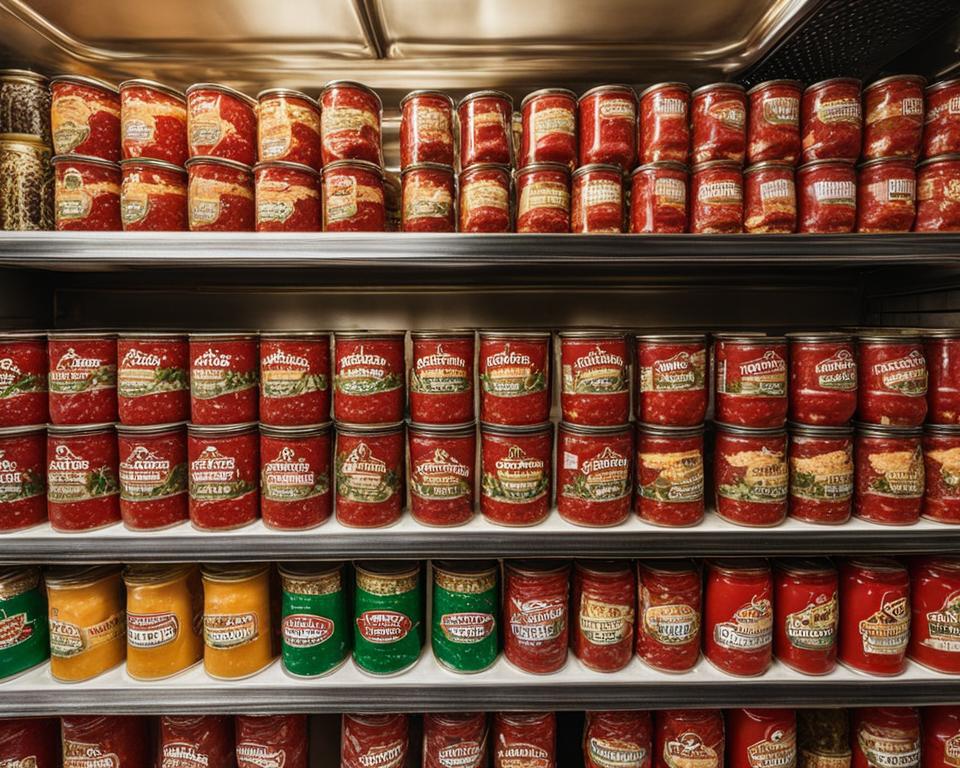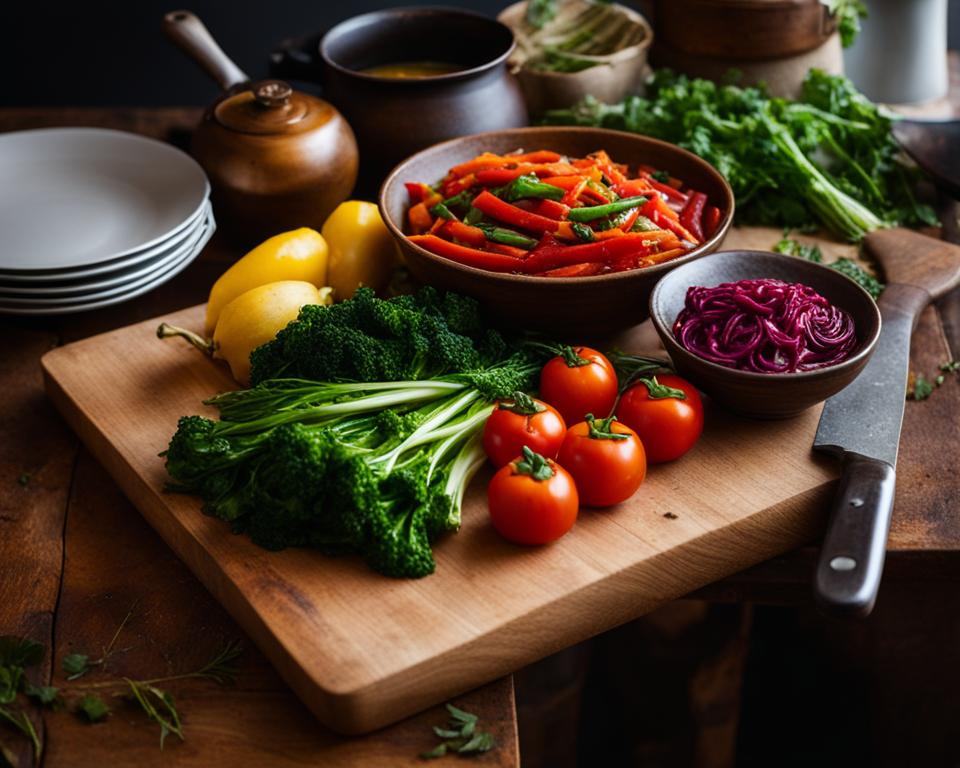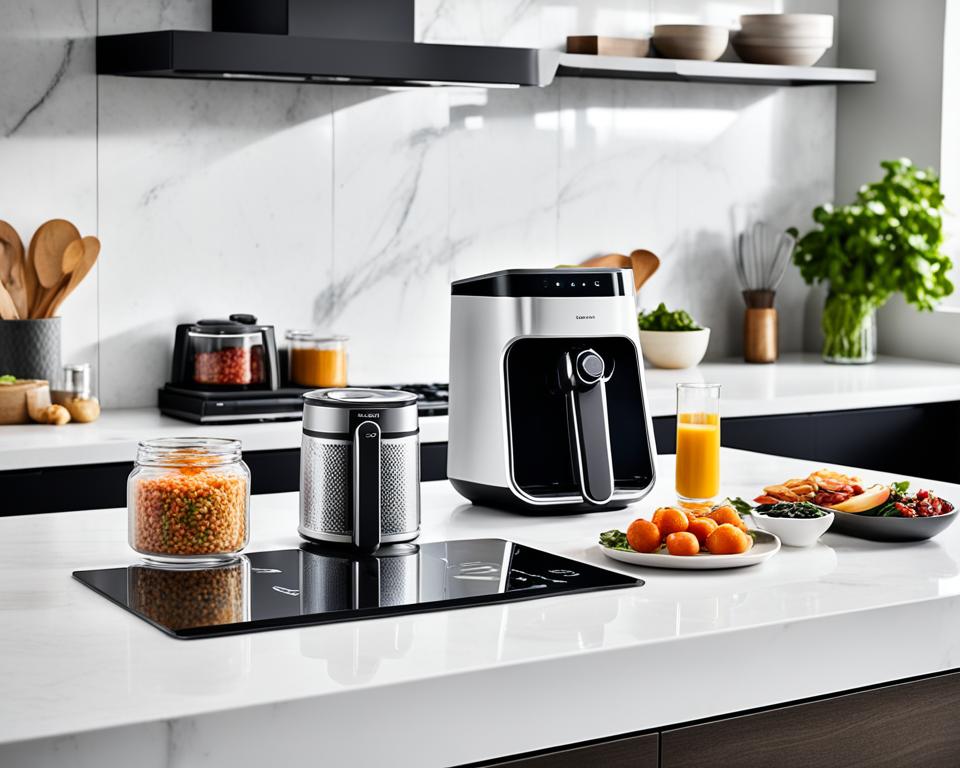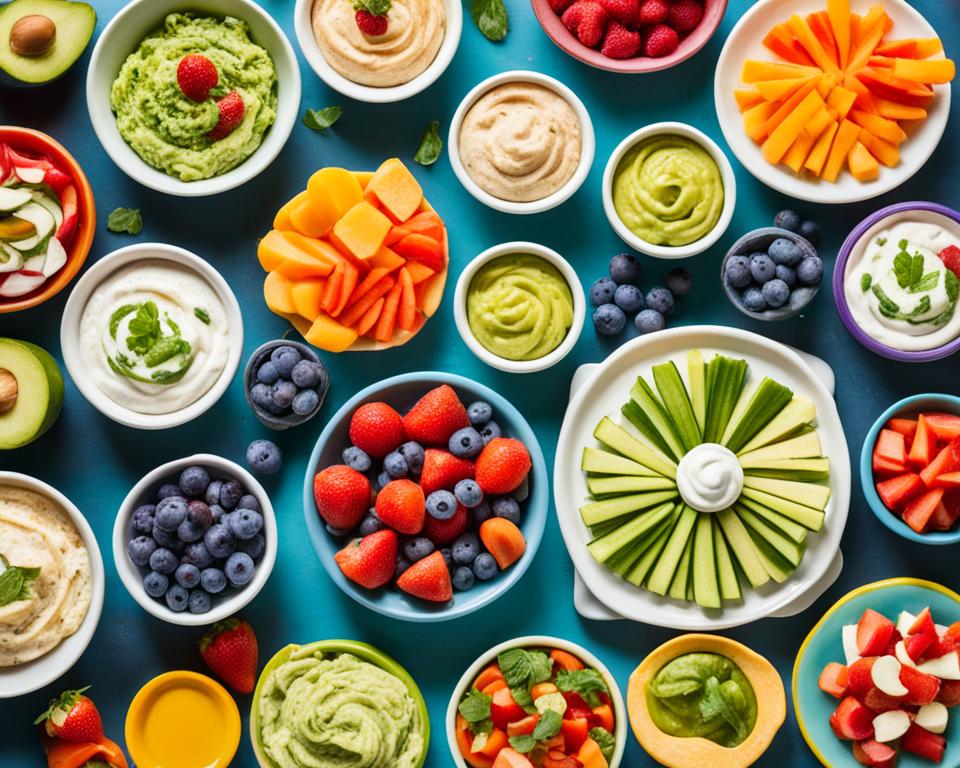Cooking delicious meals on a budget is possible with the right ingredients. By utilizing cost-effective options, you can create flavorful dishes without breaking the bank. Whether you’re a student living on a tight budget or a family looking to save money, incorporating affordable cooking ingredients into your recipes can help you stretch your dollars further.
In this article, we will explore the top 10 ingredients that are both affordable and versatile for budget cooking. From in-season fresh fruits and vegetables to pantry staples like beans and grains, these ingredients will not only provide you with budget-friendly options but also nutritious and satisfying meals.
Key Takeaways:
- Utilizing cost-effective ingredients can help you create delicious meals on a budget.
- In-season fresh fruits and vegetables are not only more affordable but also taste better.
- Frozen fruits and vegetables are a great alternative when fresh produce is not in season.
- Beans are an inexpensive and nutritious ingredient that can add flavor and bulk to various dishes.
- Canned tomatoes are a versatile and affordable ingredient that can enhance the taste of your meals.
In-Season Fresh Fruits and Vegetables
When it comes to budget cooking, one of the keys to saving money while still enjoying delicious meals is to take advantage of in-season fresh fruits and vegetables. Not only are they packed with flavor, but they also tend to be more affordable than out-of-season produce. By incorporating these budget-friendly pantry staples into your meals, you can create nutritious and satisfying dishes without breaking the bank.
But how do you know which fruits and vegetables are in season at any given time? To help you with your meal planning, our handy Vegetables by Month Chart provides a comprehensive guide to the availability of specific produce throughout the year. This chart allows you to make informed decisions about the fruits and vegetables you should be focusing on each month to ensure the best taste and value.
| Month | Vegetables in Season |
|---|---|
| January | Potatoes, kale, Brussels sprouts |
| February | Carrots, beets, turnips |
| March | Spinach, asparagus, peas |
| April | Broccoli, lettuce, radishes |
| May | Strawberries, rhubarb, zucchini |
| June | Tomatoes, cucumbers, green beans |
By planning your meals around in-season produce and utilizing the recipes provided on our website, you can make the most of these budget-friendly ingredients while enjoying the freshest flavors nature has to offer.
Benefits of In-Season Fresh Fruits and Vegetables
In-season fruits and vegetables
- Are more affordable
- Taste better
- Are at their nutritional peak
- Support local farmers
- Provide variety throughout the year
So whether you’re making a vibrant salad or a hearty stir-fry, be sure to check our Vegetables by Month Chart and take advantage of the in-season produce available to you. Not only will you be saving money, but you’ll also be creating delicious and nutritious meals that the whole family will love.
Frozen Fruits and Vegetables
When fresh produce is not in season, frozen fruits and vegetables are a fantastic alternative for budget-friendly cooking. Not only do they come at a lower price, but they also retain their nutrients, making them a healthy choice for your meals.
One of the primary advantages of using frozen fruits and vegetables is their convenience. They require minimal preparation, as they are already cleaned, chopped, and ready to use. This saves you time in the kitchen, allowing you to focus on other aspects of your budget-friendly recipes.
You can incorporate frozen fruits and vegetables into a wide range of dishes. Steam them for a nutritious side dish, roast them for added flavor and texture, or add them to savory stir-fries, heartwarming soups, and hearty rice dishes. The possibilities are endless!
Not only do frozen fruits and vegetables offer versatility, but they also have a longer shelf life compared to their fresh counterparts. This means you can stock up on them and use them whenever you need, reducing food waste and ensuring you always have budget-friendly ingredients on hand.
Here are some creative and delicious ways to incorporate frozen fruits and vegetables into your budget-friendly recipes:
- Blend frozen berries into smoothies for a refreshing breakfast or snack option.
- Add frozen peas to pasta dishes or fried rice for a pop of color and extra nutrients.
- Mix frozen spinach into casseroles, lasagnas, or omelettes to increase your veggie intake.
- Toss frozen mango chunks into salsa for a tangy twist.
- Top yogurt or oatmeal with frozen berries for a nutritious and budget-friendly breakfast.
Remember, frozen fruits and vegetables can be just as nutritious and delicious as their fresh counterparts, making them an excellent choice for budget-friendly cooking. Incorporate them into your meals to enjoy their convenience, versatility, and incredible savings.
Beans
Beans are a fantastic choice for frugal and nutritious cooking. Whether you opt for dried beans or canned beans, they offer versatility, convenience, and budget-friendly options for delicious meals. Let’s explore the benefits of each:
Dried Beans
Dried beans are a pantry staple that can be cooked in various ways. They require some advance preparation, but the end result is worth it. Here are a few key features and benefits of dried beans:
- Cost-effective: Dried beans are incredibly affordable, making them an excellent choice for budget-conscious cooks.
- Versatility: From kidney beans and black beans to chickpeas and lentils, the range of dried beans available ensures endless possibilities in your cooking.
- Customizable flavors: By cooking dried beans from scratch, you have full control over the seasonings and flavors, allowing you to tailor them to your liking.
- Health benefits: Dried beans are rich in fiber, protein, and essential nutrients, making them a nutritious addition to any meal.
Canned Beans
If you’re looking for a quick and convenient option, canned beans are the way to go. Here are some reasons why canned beans are a frugal cook’s best friend:
- Time-saving: Canned beans are pre-cooked and ready to use, eliminating the need for soaking and long cooking times.
- Convenience: Having a variety of canned beans in your pantry ensures you always have a quick and easy protein source on hand.
- Cost-effective: While canned beans may be slightly more expensive than dried beans, they still offer great value for the convenience they provide.
- Long shelf life: Canned beans have a long shelf life, allowing you to stock up when they are on sale without worrying about spoilage.
Both dried beans and canned beans can be used in a wide range of recipes. They add flavor, texture, and bulk to dishes like enchiladas, quesadillas, salads, soups, and rice. Experiment with different bean varieties and cooking methods to discover your favorite budget-friendly bean creations.
“Beans are not only versatile and nutritious but also one of the most cost-effective ingredients for frugal cooking.”
Now that we’ve explored the wonders of beans, let’s move on to another essential ingredient for budget-friendly cooking.
Canned Tomatoes
Canned tomatoes are a staple ingredient for budget-friendly cooking. Whether you prefer tomato paste, crushed tomatoes, or diced tomatoes, they offer a convenient and affordable way to add flavor and depth to a variety of dishes.
One of the advantages of using canned tomatoes is their versatility. They can be used in classic recipes like spaghetti sauce and chili, as well as in soups, stews, and casseroles. The rich and tangy flavor of canned tomatoes enhances the taste of your meals, making them more enjoyable without the need for expensive ingredients.
Not only are canned tomatoes economical, but they also save both time and effort in the kitchen. Unlike fresh tomatoes, canned varieties are available year-round and require no chopping or peeling. This means that you can enjoy the taste of ripe tomatoes even when they are out of season.
Incorporating canned tomatoes into your low-cost meal plan is a smart choice. They provide essential nutrients like lycopene, vitamin C, and potassium, making them a healthy addition to your diet. Plus, their long shelf life ensures that you always have a budget-friendly ingredient on hand when you need it.
Next time you’re looking for low-cost meal ingredients, reach for a can of tomatoes. They’ll add flavor, convenience, and affordability to your budget-friendly cooking.

Grains and Pasta
When it comes to budget-friendly pantry staples, grains and pasta are economical cooking ingredients that should be on your shopping list. Not only are they affordable, but they also have long shelf lives, making them convenient options for stocking up in bulk at reduced prices. By incorporating grains like rice, farro, and quinoa, along with dried pasta, into your meals, you can create filling dishes without straining your budget.
Grains like rice, farro, and quinoa are versatile and can be used to bulk up meals like soups, salads, and stir-fries. They provide a hearty texture and are packed with nutrients, making them a healthy and cost-effective addition to your recipes. Furthermore, whole wheat varieties offer added nutritional value, including fiber, protein, and complex carbohydrates, which can help keep you full for longer.
Dried pasta, such as spaghetti, penne, and macaroni, is another budget-friendly option that can be transformed into a variety of delicious dishes. From classic pasta recipes like spaghetti carbonara to comforting favorites like mac and cheese, pasta offers endless possibilities for affordable and satisfying meals.
Benefits of Grains and Pasta for Budget Cooking
- Cost-effective: Grains and pasta are affordable ingredients that can be purchased in bulk at reduced prices.
- Long shelf life: They have long shelf lives, allowing you to stock up and have them on hand whenever you need them.
- Versatile: Grains and pasta can be used in a wide variety of dishes, from soups and salads to main courses.
- Filling and nutritious: Whole wheat varieties of grains and pasta provide additional nutritional value, including fiber and protein, making your meals more satisfying.
“Grains and pasta are pantry staples that offer great value for your money. By incorporating these economical ingredients into your cooking, you can create flavorful and budget-friendly meals.” – Our Kitchen
Eggs
Eggs are a budget-friendly protein source and an essential ingredient for inexpensive cooking. They are versatile and can be used in a variety of dishes throughout the day, making them a valuable addition to any meal plan.
Start your day off right with a satisfying breakfast scramble or fluffy omelette. Eggs provide a boost of protein that will keep you fuller for longer, helping you stick to your budget without sacrificing nutrition.
But eggs aren’t just for breakfast. Incorporate them into your lunch or dinner by making flavorful frittatas or protein-packed sandwiches. Eggs are also a key ingredient in many baked goods, such as cakes and cookies, helping to create moist and tender textures.
Buying eggs in bulk is a savvy way to save even more money. Look for sales or consider purchasing from local farmers for fresh, affordable eggs. With their versatility and affordability, eggs are a valuable staple in any budget-conscious kitchen.
FAQ
What are the top 10 most cost-effective ingredients for budget cooking?
The top 10 cost-effective ingredients for budget cooking are fresh fruits and vegetables in season, frozen fruits and vegetables, beans (both dried and canned), canned tomatoes, grains and pasta, and eggs. These ingredients offer versatility, affordability, and the ability to create delicious meals without breaking the bank.
What are the benefits of buying fresh fruits and vegetables in season?
Buying fresh fruits and vegetables in season not only ensures better taste but also reduces costs. Seasonal produce is often priced lower and offers better quality since it is harvested at the peak of its freshness. Utilize our Vegetables by Month Chart to know when specific vegetables are in season for optimal taste and savings.
How can I make use of frozen fruits and vegetables in my budget-friendly recipes?
Frozen fruits and vegetables are a great cost-effective alternative when fresh produce is not in season. They retain nutrients and can be easily incorporated into meals. Steam, roast, or add them to stir-fries, soups, and rice for a quick and budget-friendly addition to any dish.
How can beans be used in budget cooking?
Beans are an inexpensive and nutritious ingredient for budget cooking. Dried beans can be cooked in a slow cooker or on the stovetop, while canned beans offer convenience and quick preparation. Use beans to add flavor and bulk to enchiladas, quesadillas, salads, soups, and rice, making your meals more satisfying and affordable.
What are the advantages of using canned tomatoes in cooking?
Canned tomatoes, whether in paste, crushed, or diced form, are versatile and affordable ingredients for various dishes. They add flavor and depth to recipes such as spaghetti sauce, chili, and soups. Using canned tomatoes saves both time and money while enhancing the taste of your meals.
How can grains and pasta be utilized in budget-friendly cooking?
Grains like rice, farro, and quinoa, along with dried pasta, are pantry staples that can be purchased in bulk at reduced prices. These ingredients have long shelf lives and can be used to bulk up meals like soups and salads. Opt for whole wheat varieties for added nutritional value and to make your dishes more filling and budget-friendly.
How can eggs be incorporated into budget-friendly meals?
Eggs are an excellent and affordable source of protein. They can be used in a variety of dishes throughout the day, from breakfast scrambles and omelettes to frittatas and sandwiches. Buying eggs in bulk can lead to additional savings. Incorporating eggs into your meals provides nutrition without straining your budget.





